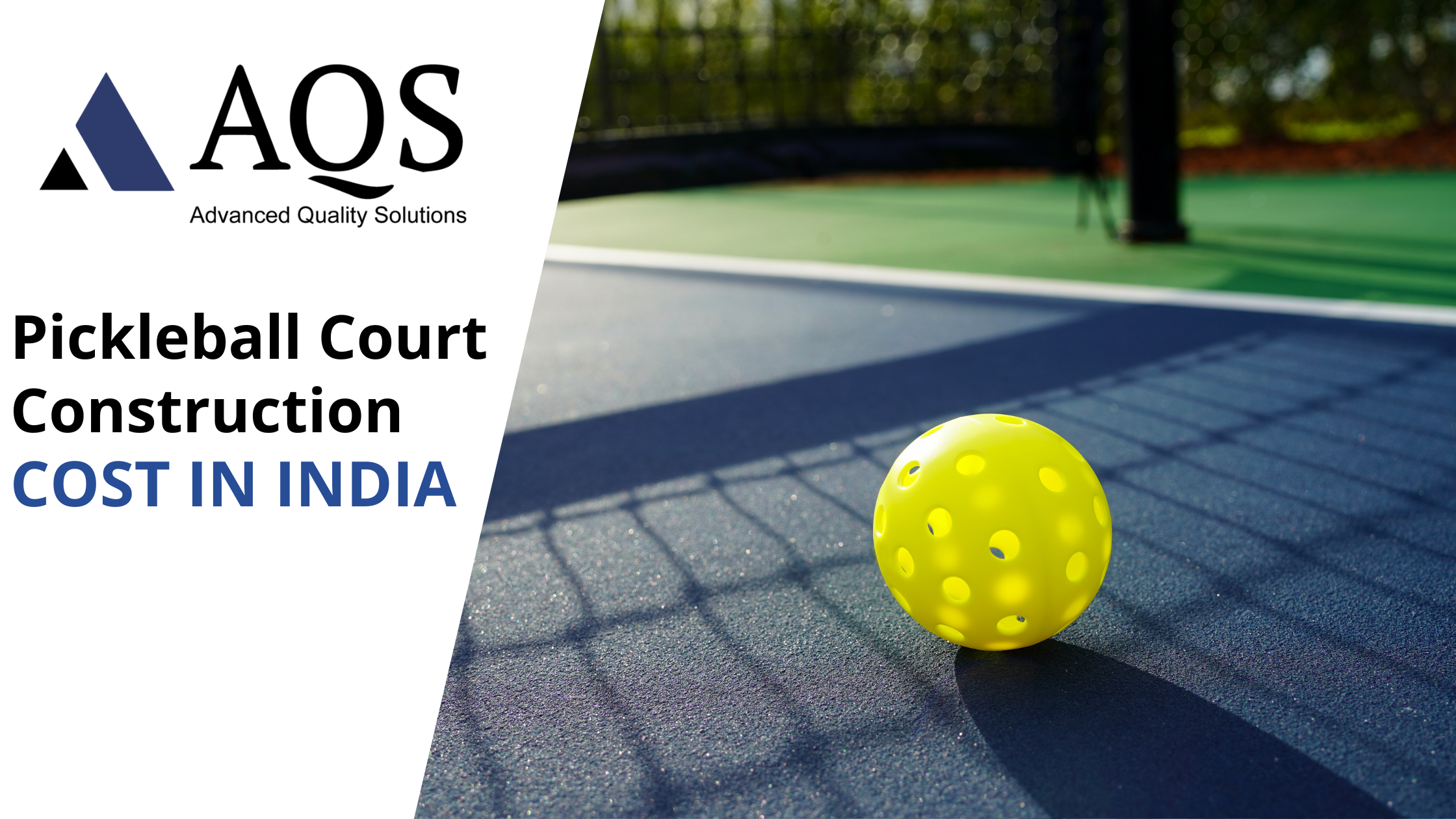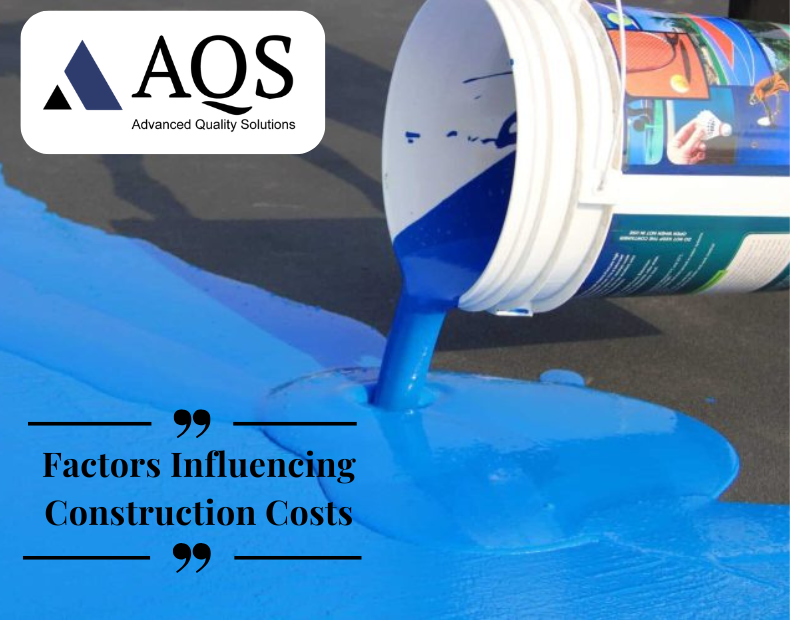
Pickleball is quickly gaining momentum throughout India, drawing in players of all ages—from youth to elderly—due to the enjoyable and speedy nature of play. As it gains popularity, the demand for quality pickleball court flooring, accurate court size, and expert construction is increasingly necessary. If you are building a court for a sports center, club, school, or private residence, knowing the pickleball court construction cost in India is imperative in making an intelligent investment.
Important aspects to consider are selecting the appropriate pickleball court size and location and using long-lasting materials such as acrylic flooring, which is both performance-driven and cost-effective in the long run. AQS is experienced in high-performance outdoor pickleball court construction with premium acrylic materials. In this blog, we discuss every facet of pickleball court construction, from cost and requirements to specifications and legalities of building a court suitable for recreational play as well as professionals.
Pickleball in India
The popularity of Pickleball is going great guns in India, particularly in urban and semi-urban regions. Schools, clubs and community centers are embracing the sport for its low entry point and societal advantages. In contrast to tennis or badminton, pickleball takes up less space, so it’s ideal for high-density urban spaces.
Significance of Quality Court Facilities As the game expands, quality infrastructure is important. Proper pickleball court installation guarantees a consistent and safe playing environment and draws more players. Community courts also make play more accessible and encourage frequent play and community development.
Factors Influencing Pickleball Court Construction Costs
Type of Court Surface
The most important consideration that will determine the overall pickleball court construction cost is the surface type. Typical surfaces are:
- Concrete: budget-friendly but not very elastic
- Asphalt: Moderate price; must be sealed and maintained on a regular basis
- Acrylic synthetic flooring (Recommended): Provides durability, UV protection, weather resistance, and enhanced gameplay performance
Durable pickleball court flooring such as acrylic can be more expensive up front but is definitely worth the money saved in long-term upkeep expenses.
Court Dimensions and Rules
The standard pickleball court dimensions are 20 feet by 44 feet for singles and doubles. Measuring the space between the boundary line and including space beyond the line, the court’s size would usually be 30 feet by 60 feet. Local space limitations or environmental changes can impact costs. Moreover, local building regulations or permits can shift project specifications.
Site Preparation and Location
The cost is greatly influenced by where you locate your court. Level, usable land has less work to prepare, yet sloping or uneven land must be graded and filled. Access, drainage, and being close to utilities also influence pickleball court construction specifications and costs.

Outdoor Pickleball Court Cost in India
Cost of outdoor pickleball court in India is between ₹2.5 lakhs to ₹5 lakhs depending on location, base preparation and flooring material. Synthetic acrylic is the most preferred as it is UV stable, anti slip surface and can withstand rain and humidity. Add-ons like fencing, LED lights and seating can increase the cost but also enhance the overall playing experience and court durability.
Indoor Pickleball Court Cost in India
For indoor pickleball courts the cost is slightly higher, averaging ₹3 lakhs to ₹6 lakhs as it involves specialized flooring with cushioning and noise reduction properties. Indoor courts are built in gyms, schools or sports complexes where controlled environment is essential for comfort and performance. The investment pays off in long run with smooth finishes, glare free surface and long lasting flooring that can withstand regular play.
Maintenance Cost of Pickleball Court
Maintenance of pickleball court is relatively low compared to other sports surfaces. Basic maintenance like sweeping dust, occasional washing and checking for cracks keeps the cost low, around ₹15,000 to ₹25,000 per annum. Resurfacing is required every 5-7 years depending on usage and climate and costs around 30-40% of the original installation cost. Regular maintenance not only extends the life but also ensures safety and playability.
How to Save Money on Pickleball Court
Builders and property owners can save money by planning the project wisely. Choosing synthetic acrylic flooring over costlier materials, optimizing the base preparation and avoiding unnecessary customizations can keep the cost low. Partnering with reliable manufacturers who provide ITF classified, ISO certified materials can ensure durability and reduce long term expenses. Investing wisely at the beginning saves money on repairs and resurfacing later and makes the court more affordable in long run.
Top Pickleball Court Builders in India
India has seen a lot of growth in pickleball infrastructure and several top court builders are offering turnkey solutions. Companies like Pacecourt, Top Flooring, AQS, SLT Sports are specialized in synthetic acrylic pickleball courts and have nationwide presence with ITF classified systems and proven track record. They not only install the court but also design, accessories and maintenance, making them one stop solution for schools, clubs, housing societies and private projects.
Budgeting for Your Pickleball Court
- Breakdown of Estimated Costs: AQS provides quality outdoor pickleball court construction services with high-quality acrylic flooring materials. Estimated construction cost in India:
- Base flooring and coating: INR 350–600 per sq. ft. (quality of material-based)
- Maintenance after construction: Normally consists of repainting, cleaning of surfaces, and filling of cracks every few years to provide durability and peak performance.
Legal and Regulatory Considerations for Pickleball Court
- Land Usage Permissions: Prior to the construction of any pickleball court, one should secure land-use permissions from the local government. Residential and commercial neighborhoods could have zoning regulations determining the type of sports facility to construct.
- Safety and Insurance: Requirements Courts should have safety procedures followed, particularly if publicly open. Liability coverage and compliance with construction safety regulations are strongly suggested in order to prevent legal issues and provide player safety.
- Environmental Factors: Reducing environmental footprint can be achieved through the use of sustainable building methods. Use water-conserving surface cleaning techniques, energy-efficient lighting, and low-VOC acrylic products. Comply with local environmental laws and perform impact assessments if necessary.
Future of Pickleball Courts in India
- Pickleball Court Design: Trends New pickleball court construction specifications are embracing technology. Acrylic-based courts that have UV protection, weather-resistant coatings, and anti-slip textures are becoming standard. Courts with built-in lighting and smart sensors for scoring are also becoming popular.
- Opportunities for Investment and Growth: As pickleball leagues and tournaments increase, there is a corresponding need for good courts. Investors and sports center developers can take advantage of this development by building attractive, multipurpose courts that are competitive in design.
- The Role of Organizations and Government: Sports federations and governments are increasingly funding the growth of racquet sports by way of grants, subsidies, and land grants. Grassroots movements are also initiating court building at schools, colleges, and public parks.
Conclusion
Pickleball is no longer a hobby of the backyard—it’s a sport with huge potential in India. From knowing the right dimensions of a pickleball court to choosing the right sports court material and allocating funds for long-term upkeep, each detail matters. AQS offers market-leading acrylic pickleball court flooring and full-service construction assistance.
For a safe, durable, and professional court that supports serious play, trust AQS’s expertise and high-quality materials.
Frequently Asked Questions
A pickleball court officially measures 20 feet wide by 44 feet long for singles and doubles. Including safety zones, the overall pickleball court size is 30 feet by 60 feet.
Synthetic acrylic flooring is the choice for durability, weather resistance and optimal playing experience. It also needs less maintenance in the long term than concrete or asphalt.
Yes, there are many backyard pickleball courts. Be sure that you have sufficient space (at least 30 x 60 feet) and local zoning regulations permit recreational construction.
Yes, construction typically needs local municipal permission, particularly if you’re constructing a commercial or public-use court. Consult zoning ordinances and land use regulations prior to commencing.
A single tennis court can made four pickleball courts utilizing portable nets and correct markings, subject to space availability and orientation of the layout



Pingback: Pickleball Court Size | AQS - Guide